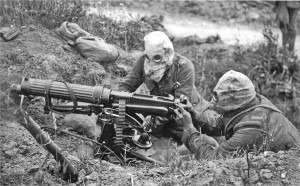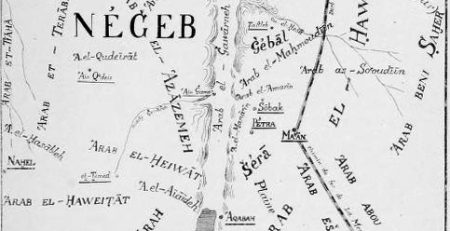Gas and Race
By On Barak
The sharp international response to the use of a sarin-like poison gas in Syria raises the question of why an international coalition can be mobilized following the murder of a few thousand people by means of gas but not following the killing of more than 100,000 people with conventional weapons. What chance is there for an alliance on that basis to prevent the continuation of the carnage in Syria? Although the international discourse on gas warfare is cloaked in moral pretensions, a historical examination of the use of chemical weapons in our region provides a clearer picture of the international community’s position. The Middle East has the questionable honor of being the first area outside Europe in which chemical weapons have been used. The first gas attack, in Gaza during World War I, was not particularly effective. Nevertheless, it provides an eye-opening—or eye-watering—context for the asymmetrical structure of the use of this weapon, a context that reveals the racial and imperial logic that guides the calibration of international diplomacy and even the moral compass of many of us.
In April 1917, during the second battle for Gaza between the British and Ottoman forces, the British fired 1,800 shells containing equal amounts of chlorine and phosgene in a futile attempt to break through the enemy’s fortified line that blocked their conquest of Palestine. Because of the weather conditions and the wind, the shelling had little effect, and there is evidence that most of the Ottoman soldiers were unaware that they had been subjected to a gas attack. The more significant innovation took place far from there, in London, in the preliminary discussions regarding the use of chemical weapons against “the Turks,” an enemy that had never used such weapons. Until that moment, the British had used chemical weapons only against the Germans, and only in response to gas attacks, and in so doing they laid the foundation for a balance of horror that has guided the (non-)use of gas to this day. The reasoning presented for the precedent-setting authorization to deviate from this framework, during a British war cabinet discussion on January 21, 1917, included the argument that “The War Cabinet, having regard to the atrocities perpetrated on the subject races by the Turks and their maltreatment of Allied prisoners during the present war, felt no hesitation in reversing the decisions – not to use gas against Turks unless the latter employed it first […]. The War Cabinet, therefore, decided that: Gas shell could be used against the Turks.”
The decisive stroke of a pen that formulated the exception provides good evidence for the general rule and reveals the range of possibilities for deviating from it. Similar language was in use at that time, as other sources indicate, and the phrase “atrocities perpetrated against subject races” directed the attention of the British decision-makers to the Armenian genocide that began in April 1915 in the Ottoman Empire, only two days after the first German gas attack in the war, on the eastern front. “The Turks” did not use gas, as their German allies did, but in their ethnic cleansing and their treatment of prisoners of war they demonstrated their inhumanity and behaved like an uncivilized race, and as such they were deserving of suitable punishment, measure for measure.

A British Vickers machine gun unit, wearing gas masks, the Battle of the Somme, 1916
Such comparisons between the type of Turkish crime (genocide) and the type of British punishment (poison gas) characterized chemical weapons—which at first were not very shocking to the public—as horrible and inhumane weapons. At the same time, in keeping with the racial logic that had seeped into the practices of using it, this weapon became a civilizing means of punishment, particularly for non-European populations. The Germans, who pioneered the use of lethal gas in war, as noted above, used this weapon in World War I indiscriminately in terms of race or religion, against the French, the Canadians, the British, the Belgians, and the Russians. But for the British, the use of this form of warfare was structured in accordance with the racial hierarchy that served them in managing a multiethnic empire. The British 1914 Manual of Military Law states that the rules of international law apply only in conflicts with “civilized nations” where both parties understand them and are prepared to carry them out. Those rules, the document states, do not apply in wars “with uncivilized States and tribes”. Starting with the attack in Gaza, at the end of World War I, and between the two world wars, the British, followed by other powers, made frequent use of gas warfare as a means of punishing and civilizing. At the end of the war, Churchill, one of the devotees of gas warfare, promoted the use of the most modern British chemical weapons against the belligerent tribes in northern India. “I am strongly in favour of using poisoned gas against uncivilized tribes,” he declared in a secret document, which he ended with the light-hearted remark, “…why is it not fair for a British artilleryman to fire a shell that makes the said native sneeze? It is really too silly.” On another occasion, Churchill expressed his support of the use of poison gases (particularly of the nonlethal type) for quashing uprisings of “uncivilized tribes” in Iraq. The Spanish used mustard gas and phosgene in 1926 to quell the Rif uprising in Morocco, and the Italians used it in 1936 in Ethiopia.
The term “subject races”—which in the protocol of the discussion in which the use of gas in Gaza was approved defines the relation between the Turks and the Armenians—served the British throughout the nineteenth and early twentieth centuries in managing their own complex empire. As the historian Mark Mazower shows, the application of the racial hierarchy in British imperial policy was the main model for the racist imperialism that the Nazis sought to implement in Europe. In fact, Mazower and other historians argue, the attraction of the racial theories that underlay European imperialism in Asia and Africa dissipated only when they were directed at the Europeans themselves. Ironically, the Germans, who first used poison gas mainly against other Europeans, internalized better than any others in World War II both the balance of horror that the British had formulated and the possibilities of deviating from it. Hitler—perhaps the most famous victim of mustard gas in the previous war—refrained from using chemical weapons against the British until the end of the Third Reich. His subordinates directed their gas stockpiles to channels that, according to the Nazi/imperial logic, were less problematic: the industrial destruction of inferior races.
Chemical weapons were considered at the beginning of the twentieth century, with great justification, as a daring leap forward in the industrialization of modern violence. The new weapons were not only the products of industrial processes; they were the fruit of new approaches to product design, remote activation, and the streamlining of the production process, for example, the reuse of industrial waste. (Phosgene, for example, was a poisonous byproduct of industrial waste for which the weapons industry found a beneficial use.) The German philosopher Peter Sloterdijk argues that chemical warfare made the distinction between people and things meaningless: Poison gases are not aimed at specific human beings but rather at the air or at other material surroundings that enable people to live as human beings. Like racism, this industrial form of violence has an objectifying effect. The punishing and civilizing power that the British and other Europeans ascribed to this kind of weapon is related to those characteristics: Poisonous and invisible gas was meant to provide a terrifying demonstration of the power of modern science and industry, a discouraging example meant to break the spirit of the primitive enemy’s forces without killing them unnecessarily.
The abovementioned internal logic is an organizing principle that explains how chemical weapons became at the same time both terrible and merciful, inhuman and humane, an efficient and economical means of punishment and discipline, on the one hand, and a wild and reckless weapon, elusive and uncontrollable, on the other hand, depending on the context. Eventually, the lethal potential of the power of modern industry became embodied in a formula in Europe according to which modern technology must not be turned against itself and its developers. On the other hand, in Asia, Africa, and the Middle East, poison gases became an extension—one of many—of the civilizing task of that same modern technology. Since World War I, the Western industrialized powers have not used chemical weapons against each other, but they have not hesitated to use them (or to support their use) against the Turks, the Moroccans, the Ethiopians, the Kurds, the Vietnamese, the Cambodians, the Iranians, and the Afghans. The imperial history of chemical weapons makes it clear why what is permitted for Jupiter is not permitted for the ox, or for the Syrian lion.
The history of chemical weapons makes very clear that the powers do not set the rules of the game because they are ethical: They do so because they can. However, if a historical examination shows the powers’ outbursts of righteous anger in an unfavorable light, their hypocrisy should not lead us to the paralyzing conclusion that no one has the right to criticize or even enforce the rules of normative behavior. As even a broken clock shows the correct time twice a day, sometimes even the hegemonic power acts in an ethical manner. And it may be that the presence of weapons inspectors will have a restraining effect on the carnage wrought by conventional weapons in Syria. However, the great danger is that internationalizing the Syrian conflict and managing it in the Security Council and the parliaments of the United States, Western Europe, the Kremlin, and China will authorize the long-term continuation of conventional killing, add sides and interests that will make the chances of a ceasefire recede, and attract military solutions that will spill more Syrian blood in order to promote the Americans’ deterrence capability, sharpen the lesson that will be taught to Iran, and achieve additional goals that are far from benefiting the Syrian population. Chemical weapons kill more people faster than do conventional weapons, and this fact alone is enough to justify attempts to stop their use. However, like this type of weapon, a civil war, perhaps the worst of all wars, does not distinguish between combatants and innocent civilians, between people and things. To deal with the chemical symptom one must deal with the root of the problem.






Leave a Reply